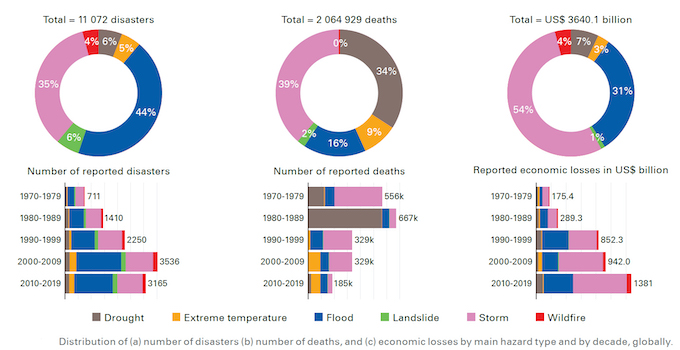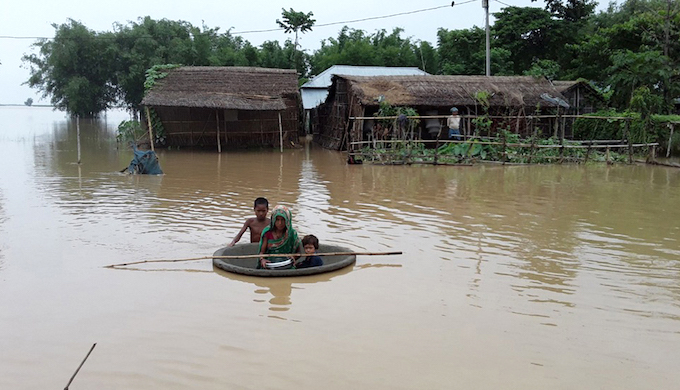Extreme weather events have risen dramatically due to climate change, the United Nations said, urging action on early warning systems to minimise losses and save lives
Kosi river floods Supaul in Bihar this monsoon (Photo by Kailash Singh)
Over the past 50 years, more than 11,000 disasters have been attributed to weather, climate and water-related hazards, resulting in two million deaths and USD 3.6 trillion in economic losses.
The average number of deaths for each disaster has fallen by a third during this period. But the number of recorded disasters has increased five times and the economic losses have increased by seven times, according to a new report by various UN bodies and international development agencies.
The rise in frequency, intensity and severity of storms, floods, droughts and wildfires as a result of climate change has hit vulnerable communities disproportionately hard.
Despite that, one in three people are still not adequately covered by early warning systems, according to the 2020 State of Climate Services report launched on October 13, on the International Day for Disaster Risk Reduction.
In 2018, around 108 million people required help globally from the international humanitarian system due to these disasters. By 2030, it is estimated that this number could increase by almost 50% at a cost of around USD 20 billion a year, the report says.

Produced by 16 international agencies and financing institutions, the report identifies where and how governments can invest in effective early warning systems that strengthen countries’ resilience to multiple weather, climate and water-related hazards and provides successful examples.
It stresses the need to switch to impact-based forecasting – an evolution from “what the weather will be” to “what the weather will do” so that people and businesses can act early based on the warnings.
The report has 16 case studies on successful early warning systems including for cyclones and hurricanes, floods, droughts, heatwaves, forest fires, sand and dust storms, locusts, severe winters and glacial lake outbursts.
However, data provided by 138 WMO members countries show that just 40% of them have Multi-Hazard Early Warning Systems (MHEWS). Only 75 countries say they provide impact-based forecasting services.
“Early warning systems (EWS) constitute a prerequisite for effective disaster risk reduction and climate change adaptation. Being prepared and able to react at the right time, in the right place, can save many lives and protect the livelihoods of communities everywhere,” said Petteri Taalas, Secretary-General of the World Meteorological Organisation (WMO), which coordinated the preparation of the report.
“While COVID-19 generated a large international health and economic crisis from which it will take years to recover, it is crucial to remember that climate change will continue to pose an on-going and increasing threat to human lives, ecosystems, economies and societies for centuries to come,“ he said.
The 16 organisations that out the report together are l’Agence Francaise de Développement, Adaptation Fund, Climate Policy Initiative, Climate Risk and Early Warning Systems initiative, Food and Agriculture Organisation of the United Nations, Group on Earth Observations, Green Climate Fund, Global Environment Facility, International Federation of Red Cross and Red Crescent Societies, Risk-informed Early Action Partnership, United Nations Office for Disaster Risk Reduction, United Nations Development Programme, World Bank Group and its Global Facility for Disaster Reduction and Recovery, World Food Programme, World Health Organisation and WMO.
Necessary Steps
An increase in climate-related disasters indicates that more money for adaptation is required, specifically for modern weather stations and related equipment.
Climate finance has improved, crossing the USD half-trillion mark in 2017-18, according to the report. But adaptation finance is only 5% of it. Money for early warning systems is a much smaller fraction.
An estimate by the Global Commission on Adaptation says USD 180 billion will be needed every year during 2020-2030.
The report makes six recommendations to improve the implementation and effectiveness of early warning systems worldwide:
- Invest to fill the early warning systems (EWS) capacity gaps, particularly in Least Developed Countries in Africa and in Small Island Developing States (SIDS);
- Focus investment on turning early warning information into early action;
- Ensure sustainable financing of the global observing system that underpins early warnings;
- Track finance flows to improve understanding of where these resources are being allocated in relation to EWS implementation needs and what impact this is having;
- Develop more consistency in monitoring and evaluation to better determine early warning systems effectiveness;
- Fill the data gaps, particularly in SIDS.
Article Credit: indiaclimatedialogue
